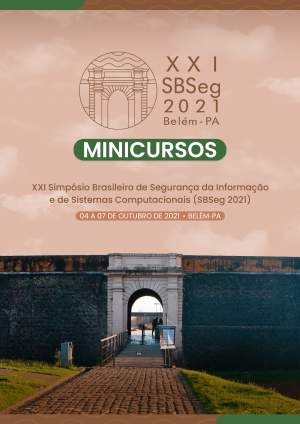Minicursos do XXI Simpósio Brasileiro de Segurança da Informação e de Sistemas Computacionais
Palavras-chave:
Segurança da Informação, Sistemas Computacionais, Minicursos, SBSeg 2021Sinopse
O Livro de Minicursos do XXI Simpósio Brasileiro de Segurança da Informação e de Sistemas Computacionais (SBSeg) traz a versão escrita das propostas aceitas e apresentadas online nesta edição do SBSeg. Nos minicursos do SBSeg há conteúdo mais práticos e também mais próximo da fronteira do conhecimento na área de cibersegurança, assim temos minicursos mais aplicados e mais teóricos nesta edição do SBSeg. Os 4 capítulos do livro de minicursos versam sobre temas como: Criptografia completamente homomórfica com implementação em Sage, Segurança e escalabilidade em sharding blockchain, Autenticação de aplicações nativas da nuvem com identidades SPIFFE e Segurança em redes 5G: oportunidades e desafios em detecção de anomalias e predição de tráfego baseadas em aprendizado de máquina. Estes capítulos do livro de minicursos tem o objetivo de atualizar os conhecimentos de profissionais que já atuam em cibersegurança e dar formação à estudantes com conteúdo que normalmente não são abordados em cursos da área.
Capítulos
-
1. Introdução à criptografia completamente homomórfica com implementação em Sage
-
2. Segurança e Escalabilidade em Sharding Blockchain
-
3. Autenticando aplicações nativas da nuvem com identidades SPIFFE
-
4. Segurança em Redes 5G: Oportunidades e Desafios em Detecção de Anomalias e Predição de Tráfego Baseadas em Aprendizado de Máquina
Downloads



